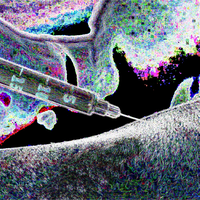| Phenobarbital | |
|---|---|
| Salts [] | |
|---|---|
| Sodium %!s( | |
| Molecular structure via molpic based on CDK |
| Physical properties [] | |
|---|---|
| Molecular mass | 232.23 g/mol [1] |
| Appearance | Crystals (3 different phases) [1] |
| Odor | Odorless [1] |
| Taste | Slightly bitter taste [1] |
| Melting point | 345 to 352 °F (NTP, 1992) [1] |
| Decomposition | When heated to decomposition it emits toxic fumes of /nitrogen oxides/. [1] |
| Solubility | >34.8 [ug/mL] (The mean of the results at pH 7.4) [1] |
| Predicted LogP | 1.5 [1] |
| Structural Identifiers [] | |
|---|---|
| Molecular formula | C12H12N2O3 [1] |
| IUPAC name | 5-ethyl-5-phenyl-1,3-diazinane-2,4,6-trione [1] |
| SMILES | CCC1(C(=O)NC(=O)NC1=O)C2=CC=CC=C2 [1] |
| InChI | InChI=1S/C12H12N2O3/c1-2-12(8-6-4-3-5-7-8)9(15)13-11(17)14-10(12)16/h3-7H,2H2,1H3,(H2,13,14,15,16,17) [1] |
| InChIKey | DDBREPKUVSBGFI-UHFFFAOYSA-N [1] |
| Pharmacokinetics[] | |
|---|---|
| Elimination half-life | 53 – 118 hours |
| Duration of action | 4 hours–2 days |
Phenobarbital
Phenobarbital (also known as Phenobarbitone, Phenobarbitol, Luminal, Phenylethylbarbiturate, Fenobarbital, Phenobarbituric acid, Phenylethylmalonylurea, Phenemal, Adonal or Nunol) is a
Chemistry
Salts []
Phenobarbital is typically found in the form of its sodium salt.
Stereochemistry []
Phenobarbital is a achiral mixture
Experience reports []
There are currently 4 experience reports involving phenobarbital on OpenErowid:
Legal status
- Australia: Phenobarbital is a S4 substance.
- Brazil: Phenobarbital is a B1 substance.[3]
- Canada: Phenobarbital is a Schedule IV substance.
- Germany: Phenobarbital is a prescription only/Anlage III substance.
- United Kingdom: Phenobarbital is a Class B substance.
- United States: Phenobarbital is a Schedule I under the "Controlled Substances Act (CSA)".
See also []
External links []
References []
National Center for Biotechnology Information. PubChem Compound Summary for CID 4763, Phenobarbital. Accessed July 13, 2025. https://pubchem.ncbi.nlm.nih.gov/compound/4763
U.S. Food and Drug Administration; National Center for Advancing Translational Sciences. Phenobarbital. UNII: YQE403BP4D. Global Substance Registration System. Accessed July 13, 2025. https://gsrs.ncats.nih.gov/ginas/app/beta/substances/YQE403BP4D
Anvisa. RDC Nº 784 - Listas de Substâncias Entorpecentes, Psicotrópicas, Precursoras e Outras sob Controle Especial. Diário Oficial da União. March 31, 2023. Accessed July 13, 2025. https://www.in.gov.br/en/web/dou/-/resolucao-rdc-n-784-de-31-de-marco-de-2023-474904992
 Anodyne
Anodyne